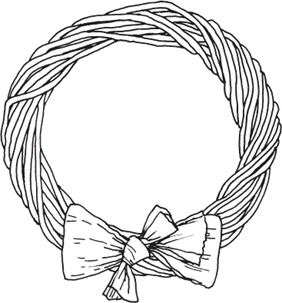M AKING GRAPEVINE WREATHS
GAYLE ODONNELL

The mission of Storey Publishing is to serve our customers by publishing practical information that encourages personal independence in harmony with the environment.
Editing and text production by Heather Clemow
Illustrations by Alison Kolesar
Cover design by Carol J. Jessop (Black Trout Design)
1996 by Storey Publishing, LLC
All rights reserved. No part of this bulletin may be reproduced without written permission from the publisher, except by a reviewer who may quote brief passages or reproduce illustrations in a review with appropriate credits; nor may any part of this bulletin be reproduced, stored in a retrieval system, or transmitted in any form or by any means electronic, mechanical, photocopying, recording, or other without written permission from the publisher.
The information in this bulletin is true and complete to the best of our knowledge. All recommendations are made without guarantee on the part of the author or Storey Publishing. The author and publisher disclaim any liability in connection with the use of this information. For additional information please contact Storey Publishing, 210 MASS MoCA Way, North Adams, MA 01247.
Storey books and bulletins are available for special premium and promotional uses and for customized editions. For further information, please call 1-800-793-9396.
Library of Congress Cataloging-in-Publication Data
ODonnell, Gayle
Making grapevine wreaths / by Gayle ODonnell
p. cm
A Storey Publishing Bulletin, A-150
ISBN 978-0-88266-445-3 (alk. paper)
1. Wreaths. I. Title.
TT899.75.036 1996
745.92dc20
96-1982
CIP
 Making Grapevine Wreaths
Making Grapevine Wreaths
For nearly twenty years, Ive dabbled in everything from sewing, crocheting, and needlework to pottery, macram, and leathercrafts. In later years, I took up basketry and broom making. But never before have I found something as enjoyable and interesting as crafting with grapevine. Grapevine grows wild and is naturally abundant. Grapevines are easy to find and pick, and easy and fun to work with, as youll discover.
After reading this booklet, you will be able to take a pile of freshly cut grapevine branches and design beautiful wreaths of many sizes, shapes, and patterns. My instructions are simple and basic. Anyone can create with grapevine and make unique, original, and natural gifts and decorations with hardly any tools or money.
I now invite you to explore the fascinating and natural world of grapevine and enjoy discovering what you can design and create from nature.

 All About Grapevine
All About Grapevine
The grape is a wild, thornless, woody, high-climbing, long-living vine of many varieties found in the woods and thickets, bottomlands and streambanks, and fertile and sandy soils throughout the country. It can be found tumbling over fences and stone walls, weaving itself through bushes, and hanging like ropes from tall trees. Grapevine climbs by means of tendrils. A tendril is actually a leafless stem, which twirls and coils itself around a support like a tree branch or another part of the grapevine. The first explorers of North America found so much wild grapevine that they named the new land Vineland. Grapes are cultivated throughout the world for use by the wine industry. The famous Concord grape and other cultivated varieties were developed from the wild fox grape or North American grape.
The wild grapevine generally appears as a stringy, woody, tangled web of reddish-brown twigs and branches, which seem to grow every which way. The vines are always visible throughout the seasons. Young leaves sprouting off the bare vines appear pinkish towards the middle to the end of April depending on where you live, becoming large and round, toothed, sometimes heart-shaped and often lobed as they mature. They form heavy, leafy canopies by summertime as they drape themselves over bushes and stone walls and hang from trees. In the autumn the leaves turn a rich yellow color, then drop to reveal their delicious fruits, exposing the abundant reddish-brown vines among the vegetation.
The grapes are bluish-black, ripening generally in September, sometimes by the end of August. When ripe, their aroma fills the air! Many songbirds and animals feed on the wild grapes, such as grouse, partridge, pheasant, wild turkey, skunk, fox, raccoon, rabbit, squirrel, possum, and coyote.
There is quite a wide variety of wild grapes: chicken, fox, possum, cat, river, summer, winter, frost, bull, pigeon, bunch, muscadine, scuppernong, New England, silverleaf, postoak, dune, sand, and bush. Wild grapes make delicious wine, juice, jelly, and preserves. Grapes are rich in iron and vitamins and are a source of instant energy. They are delicious eaten plain right off the vine, or can be sun-dried for future use. The leaves can be stuffed or rolled. Ancient herbal practitioners prescribed the dried fruit for chest disorders, the leaves were used for wounds, and branch ashes for whitening teeth.
Grapevine comes in all shapes, sizes, and lengths; in shades of reddish-browns, tans, greens, and greys. There is a very old vine that is as thick as a baseball bat, vine so long that kids can swing on it, and vine as thin as yarn. It can have all kinds of natural bends, twists, and angles. Older vine can be rather long, thick, and branched. It usually has a couple of layers of bark, the outer bark being loose and shaggy. The vine underneath is generally of a tan color. Despite their size, the older vines are amazingly flexible.
Young vines are the newer shoots which havent had many years in the elements. There is usually a single, tough, stringy layer of bark in shades of browns to reds to purples, and some varieties have a waxy feel to the bark. These vines are generally less branched, can be quite long, and have wonderful new curling tendrils. Underneath the bark, the vine is very green. This vine is still flexible but it does tend to break more easily. Vines can take on a silver-grey color from being very old and weathered, the same way cedar and other woods change color with age.
Picking Attire
Picking attire for collecting grapevine should consist of old clothes including long pants, long sleeves, and gloves to avoid cuts, scratches, splinters, and the like. Dont wear a sweater because the vines branches and tendrils will get hooked in it and everything else, from clothes to jewelry to glasses to shoelaces. It is not a bad idea to wear eye protection to guard from falling debris or being poked in the eye with a branch.
The vines should be gathered fresh. Some sources suggest soaking vines that are not fresh in water until pliable, but I find it just as easy to pick fresh vines. The vines are flexible, pliable, and can be bent and twisted quite easily. As they dry out, they keep their shape very well. The vines dont have to be used immediately. After it is picked, the vine can remain outside unused for a few weeks, more or less, depending on the size of the vine and the weather. The thicker and heavier the vine is, the longer it can sit outside, especially if the weather is cold and/or wet. The thinner the vine and the drier and hotter the weather is, the more quickly it will dry out. As long as there is some flexibility to a cut vine there is no problem in using it. Youll know soon enough if it is too dry as you use it.




 Making Grapevine Wreaths
Making Grapevine Wreaths